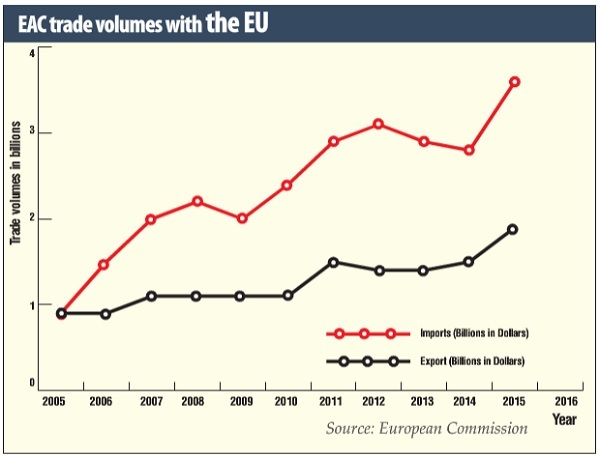
The EAC is not the only entity that is still dilly-dallying the EPA. For nearly a decade now, India has failed to agree and eventually sign the trade deal with the EU with both sides having major differences on crucial issues such as intellectual property rights, duty cut in automobile and spirits, and liberal visa regime.
EU wants India to lower tariff rates on its automobiles and wines and spirit, a demand that the latter feels may result in more imports than exports. Also, India thinks that non-tariff barriers such as sanitary and phytosanitary measures, and technical bottlenecks are the real barriers to trade. In addition, EU has been imposing stringent labeling requirements and trademark norms, for instance, which have dented India’s exports.
Similarly, the US and EU have also failed to sign the trade deal, with the EU arguing that it cannot open up its market for agricultural products from the former.
Some experts including Kwasi Adu-Amankwah, the general secretary of the African Regional Organisation of the International Trade Union Confederation, argue that it’s not fair that key stakeholders such as trade unions have been excluded from the negations.
He says the continent’s share of global trade has fallen from 6% in the 1980s to 1.7 % in 2015, with Africa accounting for only 4.4 % of global Foreign Direct Investments in 2014 despite the mouth-watering incentives made available to foreign investors.
“There are reasons for this state of affairs,” he says. “The market access offered under previous trade agreements was contrived. As the tariffs came down on African raw materials, they went up for manufactures.”
The EAC has experienced trade deficits with the EU over the last 15 years, resulting into frequent depreciation of local currencies.
Amankwah adds that poor countries have been at a disadvantage with non-tariff barriers including unreasonable sanitary and phyto-sanitary measures replaced the tariffs as European exporters continued to benefit from huge levels of subsidies that enabled them to out-compete their African counterparts.
Above all, African economies had very little beside raw materials to export to the European markets, and the colonial economic structure set-up to export raw materials and import manufactures remains intact.
He says IMF’s policy to liberalise economies in developing countries in the 1980’s, meant that barriers to trade such as import taxes and quotas, which had protected local industries especially in the Sub-Saharan Africa, had to be removed. This unfortunately did not happen, which led to the collapse of textile industries resulting to a surge in the influx of second-hand clothes into many developing countries including Kenya, Ghana, Malawi, Nigeria, Rwanda, Tanzania, Zambia and Zimbabwe as textiles industries folded their operations, according to Andrew Brook, in his book; ‘Clothing Poverty: The Hidden World of Fashion and Second Hand Clothes’.
Now accounting for over 50% of the clothing market in Sub-Saharan Africa and 81% in Uganda, the influx of the second hand clothes resulted into loss of numerous jobs on the continent.
Amankwah says the EPAs, as currently structured, have no remedy for these challenges. Instead, the agreements are destined to make the situation even worse for African economies.
He notes that while trade can be an important instrument in the fight against poverty and deprivation in Africa, it is highly insincere to conceive of a free trade between the poorest continent on Earth and the world’s most powerful trading bloc as the solution.
Private sector in support
However, the private sector in Uganda is not as worried as the civil society groups. Officials say signing the EPA would result in the smooth flow of raw materials from EU tax free and thus promote industrialisation.
Gideon Badagawa, the executive director at the Private Sector Foundation Uganda, told The Independent that signing the agreement would also help local manufacturers build capacity for local industries and thus be able to produce for both local, regional, and international market.
“As far as the negotiations are concerned, they will not be implemented at once. They will start with access to raw materials and later finished products,” Badagawa, said.
Looking forward, Nalunga says Kenya could apply for the Generalized Scheme of Preferences (GSP), but it would not be eligible for full duty-free access to the EU market.
But GSP arrangements are narrower in scope than EPAs since it covers only market access and does not include any development assistance, in the form of either financial aid or technical cooperation. She adds that Kenya need to be treated as LDC because all her neighbouring states are still poor.
But other analysts say the EU must change its approach to trade so that the aspirations of its trade for all strategy to strengthen human rights and sustainable development through trade become a reality.
They want to call on the European Commission to drop this proposal and allow East African countries the freedom to decide through a democratic process whether or not to accept the EPA rather than forcing it down their throats.
The European Parliament was scheduled to start debate an EPA with Southern African Development Cooperation (SADC) on Sept 14. Over the last 20 years, EU has consistently been the leading exporter among the regional trade agreements, accounting for 33 % of world trade in 2014, the World Trade Organisation report 2015 says.
In Africa, however, the share of the Common Market for Eastern and Southern Africa in world merchandise exports has remained at the 1995 level of 0.5 % while SADC increased its share from 0.9 % 1.1 during the same period.
EAC-EA deal timeline:
February 1975 – EU and 71 ACP countries endorse “Lome Convention”
February 29, 2000 – 25-year old Lome Convention is expired after three renewals
June 23, 2000 – Cotonou Partnership Agreement signed
Oct. 13, 2007 – EPAs proposed to replace Cotonou Pact
Dec. 31, 2007 – Cotonou deal expires
Dec. 31, 2007 – EU & EAC sign interim/framework EPAs (FEPA)
Oct. 01, 2014 – New deadline for final signing passes.
January 2016 – Kenya removed from duty-free access to EU bloc.
July 2016 – Tanzania, Uganda refrain from further negotiations
Sept. 08, 2016 – EAC Summit extends final signing to January 2017
 The Independent Uganda: You get the Truth we Pay the Price
The Independent Uganda: You get the Truth we Pay the Price



and ypu call this dilly dallying? Are you paid by EU as propagandist? Kenya must sign for it has things to GAIN, Rwanda has no business to talk of but Tanzania and Uganda must negotiate well, irrespective of who has signed.